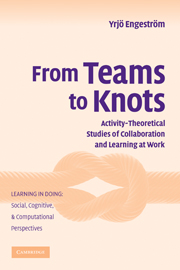Book contents
- Frontmatter
- Contents
- Series Foreword
- Preface
- 1 Teams and the Transformation of Work
- 2 Disturbance Management and Masking in a Television Production Team
- 3 Teamwork between Adversaries: Coordination, Cooperation, and Communication in a Court Trial
- 4 Displacement and Innovation in Primary Care Medical Teams
- 5 Crossing Boundaries in Teacher Teams
- 6 Knowledge Creation in Industrial Work Teams
- 7 Teams, Infrastructures, and Social Capital
- 8 From Iron Cages to Webs on the Wind
- 9 Knotworking and Agency in Fluid Organizational Fields
- References
- Author Index
- Subject Index
- Titles in the series
9 - Knotworking and Agency in Fluid Organizational Fields
Published online by Cambridge University Press: 05 June 2012
- Frontmatter
- Contents
- Series Foreword
- Preface
- 1 Teams and the Transformation of Work
- 2 Disturbance Management and Masking in a Television Production Team
- 3 Teamwork between Adversaries: Coordination, Cooperation, and Communication in a Court Trial
- 4 Displacement and Innovation in Primary Care Medical Teams
- 5 Crossing Boundaries in Teacher Teams
- 6 Knowledge Creation in Industrial Work Teams
- 7 Teams, Infrastructures, and Social Capital
- 8 From Iron Cages to Webs on the Wind
- 9 Knotworking and Agency in Fluid Organizational Fields
- References
- Author Index
- Subject Index
- Titles in the series
Summary
In this chapter, I make an attempt to hybridize three relatively separate fields of inquiry: (1) theories and studies of collective intentionality and distributed agency, (2) theories and studies of social capital in organizations, and (3) cultural-historical activity theory.
I argue that employees' collective capacity to create organizational transformations and innovations is becoming a crucially important asset that gives a new, dynamic content to notions of collaborative work and social capital. In philosophy, sociology, anthropology, and cognitive science, such capacity is conceptualized as distributed agency or collective intentionality (e.g., Barnes, 2000: Meggle, 2002). The problem with theories of intentionality and agency is that they are seldom grounded in empirical observations or interventions in people's daily realities and practices at work.
Theories and studies of social capital in organizations, on the other hand, have largely focused on the value-generating potential of social ties, network relations, and trust (e.g., Lesser, 2000: Lin, Cook, & Burt, 2001). Issues of agency and intentionality have remained marginal in this literature. Furthermore, this literature has not dealt with issues of transformations in work and emergence of new organizational forms. On the other hand, there are indications of emerging interest in issues of volition, intentionality, and energy as organizational assets, evidenced, for example, in the recent papers by Ghoshal and Bruch (2003) and Cross, Baker, and Parker (2003).
I suggest that cultural-historical activity theory can serve as a challenging mediator between agency and intentionality, on the one hand, and social capital, on the other hand.
- Type
- Chapter
- Information
- From Teams to KnotsActivity-Theoretical Studies of Collaboration and Learning at Work, pp. 199 - 234Publisher: Cambridge University PressPrint publication year: 2008
- 1
- Cited by



